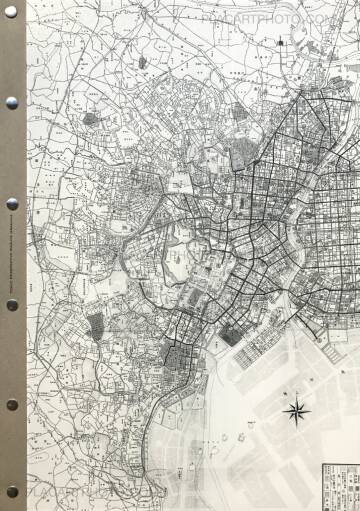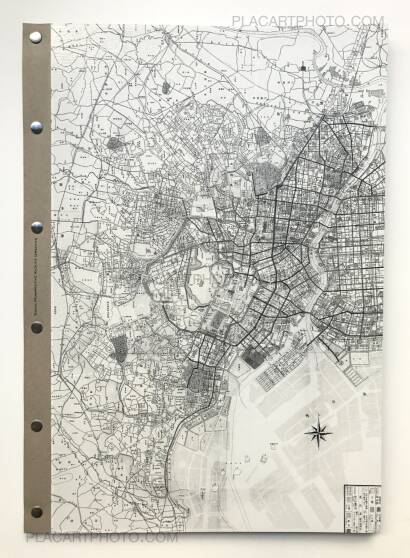Tokyo Perspective (ONLY 50 COPIES - SIGNED)
.jpg)
Kazuya Urakawa
Tokyo Perspective (ONLY 50 COPIES - SIGNED)
Photographs: Kazuya Urakawa
Text: Kazuya Urakawa
Publisher: Reminders Project
134 pages
Pictures: 57
Year: 2016
Comments: Hardcover, 415 x 295 mm. First edition, 2016. Design by Yumi Goto and Jan Rosseel. Edition limited to 50 numbered and signed copies.
Looking at cityscapes in Tokyo, I often feel as if the city has fallen into a state of amnesia. This feeling is awoken by the scrap-and-build approach that Tokyo has repeated more frequently than any other city in the world, whether due to man-made factors or otherwise. In particular, the twin catastrophes of the Great Kanto Earthquake (1923) and the Great Tokyo Air Raid (1945) and the subsequent reconstructions thereafter are two of the chief causes.
However, scrap-and-build has been accelerated by economic motives in pursuit of rationality and efficiency since the 1980s, when Japan enjoyed the bubble economy, we commonly see the buildings demolished as young as 50 years old. In contrast, facing a vacant lot after a building was demolished, we cannot remember the building that used to stand there. This indicates not only that buildings truly fall into oblivion after their demolition but also that we don’t take note of them in the city in a meaningful way. Although architecture is generally regarded as an art, I feel that people may not think so in Japan.
Italian architect Aldo Rossi talks about the relation between locus and architecture in the city in his evocative book “Architecture of the city”.
These [locus] outlines delineate the singularity of monuments, of the city, and of buildings, and thus the concept of singularity itself and its limits, where it begins and ends. They trace the relation of architecture to its location ― the place of art ― and thereby its connections to, and the precise articulation of, the locus itself as a singular artifact determined by its space and time, by its topographical dimensions and its form, by its being the seat of succession of ancient and recent events, by its memory. (Aldo Rossi, Architecture of the City, The MIT Press, 1984, P107)
The relation between scrap-and-build and the memory-loss for the city is comparable to two sides of the same coin, and the excessively frequent scrap-and-build approach overtakes the accumulation of memory. I suppose that the memory-lost city can never retrieve those lost memories and will therefore lose singularity ― lose itself.
.jpg)
.jpg)
.jpg)
.jpg)
.jpg)
.jpg)
.jpg)
.jpg)
.jpg)
more books tagged »signed« | >> see all
-
Shibuya Scramble (Signed)
by Jesper Haynes
sold -
Linger/ Teikai (ONLY 77 COPIES - SIGNED)
by Daisuke Yokota
sold -
Beyond borders (LTD & SIGNED)
by Frederic Lezmi
sold -
Cul de sac (handmade 79 copies)
by Tomasz Laczny
Euro 200 -
E.D.S.A (LTD SIGNED EDT)
by Elisabeth Neudörfl
sold -
1980 Roppongi Soul Embassy (SIGNED)
by Susumu Fujita
sold
more books tagged »yumi goto« | >> see all
-
The Restoration Will (ONLY 87 COPIES)
by Mayumi Suzuki
sold -
Bird, Night and then (Only 55 copies)
by Kenji Chiga
sold -
The Restoration Will (CEIBA EDT)
by Mayumi Suzuki
sold -
Dear Japanese (ONLY 70 COPIES)
by Miyuki Okuyama
sold -
I AND THOU (Signed and numbered, edt of 72)
by Mi-Yeon
sold -
Dear Japanese
by Miyuki Okuyama
sold
more books tagged »tokyo« | >> see all
-
Shakyojin iro nikki (Photo Maniac's Color Diary)
by Nobuyoshi Araki
sold -
Tokyoites (Tokyo-Jin) (SIGNED)
by Yutaka Takanashi
Euro 520 -
TOKYO COMPRESSION REVISITED SIGNED
by Michael Wolf
sold -
TOKYO
by Samuel Bollendorff
Euro 15 -
Machi – Town (Inscribed copy)
by Yutaka Takanashi
Euro 1000 -
Son of a BIT
by Yasuhiko Uchihara
sold
more books tagged »architecture« | >> see all
-
CLUB & COURTS YOKOSUKA YOKOHAMA (SIGNED)
by Miyako Ishiuchi
sold -
PASSENT LES HEURES BLANCHES
by Yannig Hedel
sold -
Contemporary Architecture of the West
by El Lissitsky
sold -
DE BĒTON ET DE LUMIĒRE
by Olivier Roche
sold -
Kleine Fotoenzyklopädie (SIGNED)
by Guadalupe Ruiz
sold -
Toshi no Zokei
by Seiji Kurata
Euro 35
more books tagged »limited edition« | >> see all
-
American Cowboy (SIGNED)
by Karoliina Paatos
sold -
NORMADRINE (Limited Edition /50)
by Véronique Bourgoin
sold -
Kings of Faro (Signed)
by André Wolff
sold -
Mass
by Hiroshi Takizawa
sold -
New York (Signed)
by Daisuke Yokota
sold -
40) Remake (Signed Limited Edition / 40 copies)
by Véronique Bourgoin
Euro 350
more books tagged »reminders project« | >> see all
-
Happn (ONLY 56 COPIES - SIGNED)
by Kenji Chiga
sold -
Hiroshima Graph - Everlasting Flow (Ltd edition of 75)
by Yoshikatsu Fujii
sold -
Snowflakes Dog Man (ONLY 69 COPIES - SIGNED)
by Hajime Kimura
sold -
Hodophylax (ONLY 111 COPIES - SIGNED)
by Michiko Hayashi
sold -
Hiroshima Graph : Rabbits abandon their children (ONLY 72 COPI...
by Yoshikatsu Fujii
sold -
Red String (ONLY 35 COPIES)
by Yoshikatsu Fujii
sold
more books tagged »japanese« | >> see all
-
The Blues of Monochrome
by Masanori Kamide
sold -
Taratine (Signed)
by Daisuke Yokota
sold -
Document : Shonimahi no kiroku / Document : Record of Infantil...
by Tadao Mitome
Euro 200 -
Shisen / The Look
by Joji Hashiguchi
sold -
CORRESPONDENCE
by Hajime Kimura
sold -
Silent Histories (Only 45 copies)
by Kazuma Obara
sold
Books from the Virtual Bookshelf josefchladek.com














































;jpg)
;jpg)

 Facebook
Facebook Instagram
Instagram